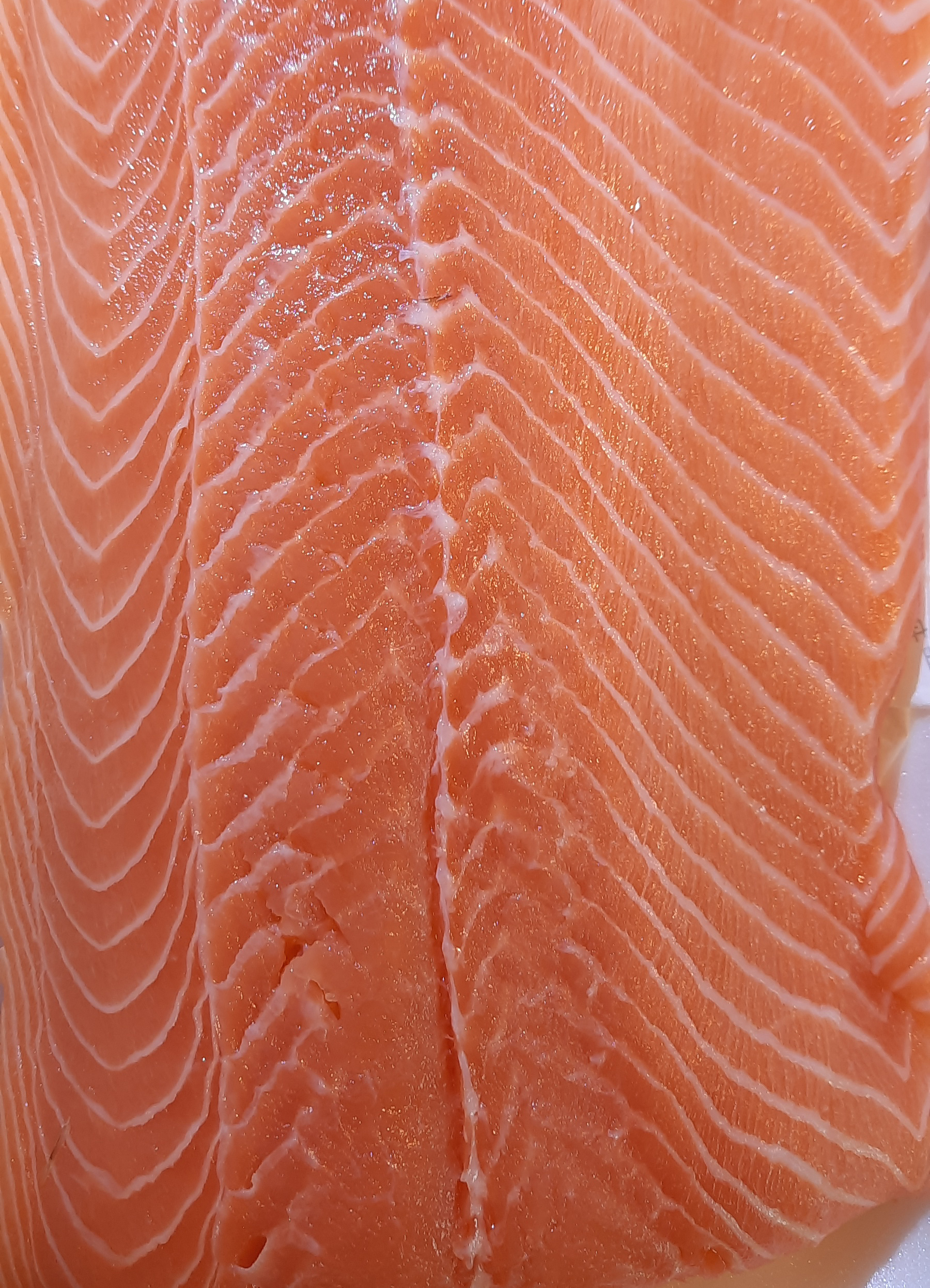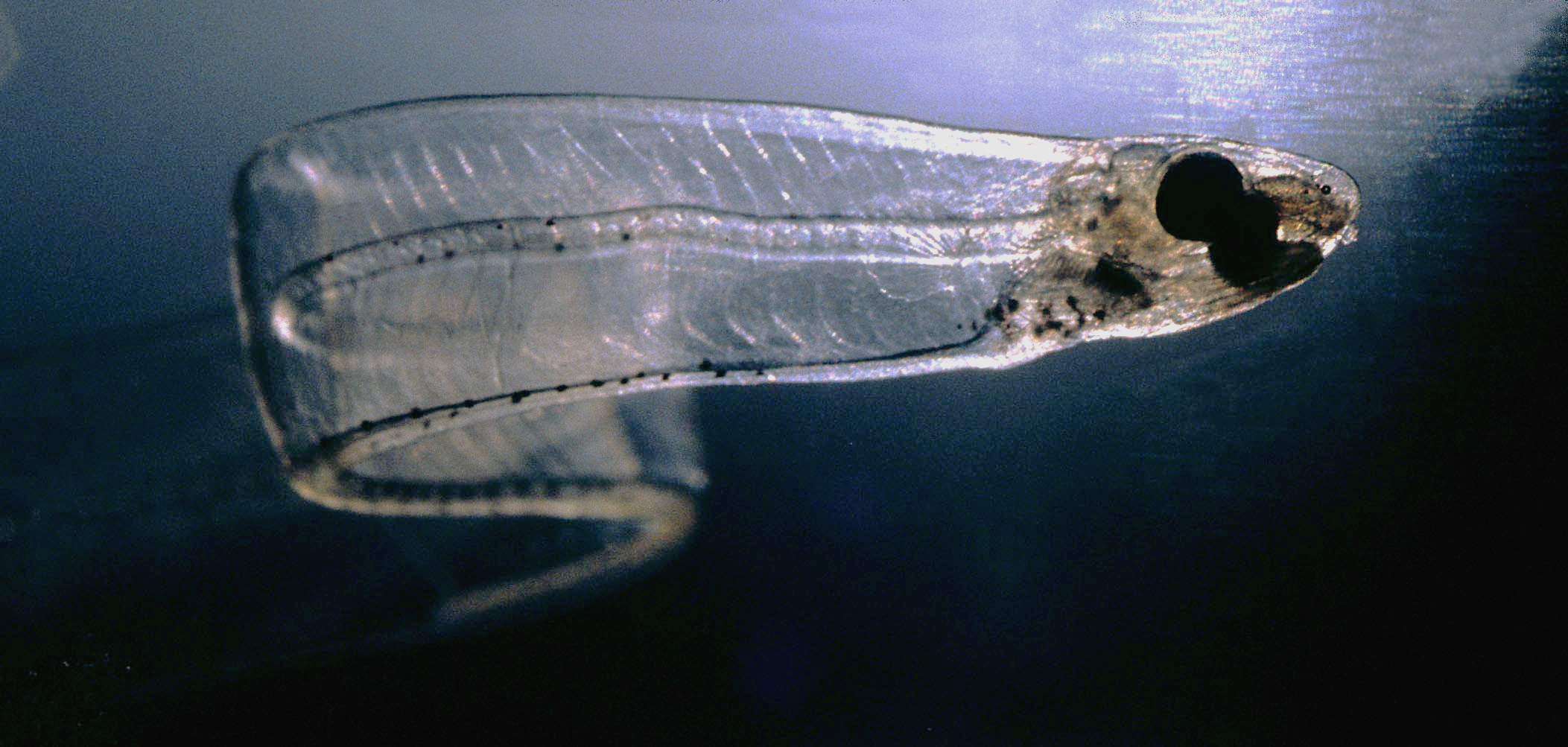|
Myomere
Myomeres are blocks of skeletal muscle tissue arranged in sequence, commonly found in aquatic chordates. Myomeres are separated from adjacent myomeres by connective fascia (myosepta) and most easily seen in larval fishes or in the olm. Myomere counts are sometimes used for identifying specimens, since their number corresponds to the number of vertebrae in the adults. Location varies, with some species containing these only near the tails, while some have them located near the scapular or pelvic girdles. Depending on the species, myomeres could be arranged in an epaxial or hypaxial manner. Hypaxial refers to ventral muscles and related structures while epaxial refers to more dorsal muscles. The horizontal septum divides these two regions in vertebrates from cyclostomes to gnathostomes. In terrestrial chordates, the myomeres become fused as well as indistinct, due to the disappearance of myosepta. Shape The shape of myomeres varies by species. Myomeres are commonly zig-zag, " ... [...More Info...] [...Related Items...] OR: [Wikipedia] [Google] [Baidu] |
Cambrian Chordate
The Cambrian chordates are an extinct group of animals belonging to the phylum Chordata that lived during the Cambrian, between 485 and 538 million years ago. The first Cambrian chordate known is '' Pikaia gracilens'', a lancelet-like animal from the Burgess Shale in British Columbia, Canada. The discoverer, Charles Doolittle Walcott, described it as a kind of worm (annelid) in 1911, but was later realised to be a chordate. Since the discovery of other Cambrian fossils from the Burgess Shale in 1991, and from the Chengjiang biota of China in 1991, which were later found to be of chordates, several Cambrian chordates are known, with some fossils considered as putative chordates. The Cambrian chordates are characterised by the presence of segmented muscle blocks called myomeres and notochord, the two defining features of chordates. Before the full understanding of Cambrian fossils, chordates as members the most advanced phylum were believed to appear on Earth much later than the Cam ... [...More Info...] [...Related Items...] OR: [Wikipedia] [Google] [Baidu] |
Amphioxus
The lancelets ( or ), also known as amphioxi (singular: amphioxus ), consist of some 30 to 35 species of "fish-like" benthic filter feeding chordates in the order Amphioxiformes. They are the modern representatives of the subphylum Cephalochordata. Lancelets closely resemble 530-million-year-old ''Pikaia'', fossils of which are known from the Burgess Shale. Zoologists are interested in them because they provide evolutionary insight into the origins of vertebrates. Lancelets contain many organs and organ systems that are closely related to those of modern fish, but in more primitive form. Therefore, they provide a number of examples of possible evolutionary exaptation. For example, the gill-slits of lancelets are used for feeding only, and not for respiration. The circulatory system carries food throughout their body, but does not have red blood cells or hemoglobin for transporting oxygen. Lancelet genomes hold clues about the early evolution of vertebrates: by comparing genes from ... [...More Info...] [...Related Items...] OR: [Wikipedia] [Google] [Baidu] |
Leptocephalus
Leptocephalus (meaning "slim head") is the flat and transparent larva of the eel, marine eels, and other members of the superorder Elopomorpha. This is one of the most diverse groups of teleosts, containing 801 species in 4 orders, 24 families, and 156 genera. This group is thought to have arisen in the Cretaceous period over 140 million years ago.Inuoe, Jun, M. Miya, et al. “Mitogenomic evidence for the monophyly of elopomorph fishes (Teleostei) and the evolutionary origin of the leptocephalus larva.” Molecular Phylogenetics and Evolution 32 (2004): 274-286. Web. 2 Nov. 2012. Fishes with a leptocephalus larval stage include the most familiar eels such as the conger, moray eel, and garden eel as well as members of the family Anguillidae, plus more than 10 other families of lesser-known types of marine eels. These are all true eels of the order Anguilliformes. Leptocephali of eight species of eels from the South Atlantic Ocean were described by Meyer-Rochow The fishes of ... [...More Info...] [...Related Items...] OR: [Wikipedia] [Google] [Baidu] |
Aquatic Animal
An aquatic animal is any animal, whether invertebrate or vertebrate, that lives in water for most or all of its lifetime. Many insects such as mosquitoes, mayflies, dragonflies and caddisflies have aquatic larvae, with winged adults. Aquatic animals may breathe air or extract oxygen from water through specialised organs called gills, or directly through the skin. Natural environments and the animals that live in them can be categorized as aquatic (water) or terrestrial (land). This designation is polyphyletic. Description The term aquatic can be applied to animals that live in either fresh water or salt water. However, the adjective marine is most commonly used for animals that live in saltwater, i.e. in oceans, seas, etc. Aquatic animals (especially freshwater animals) are often of special concern to conservationists because of the fragility of their environments. Aquatic animals are subject to pressure from overfishing, destructive fishing, marine pollution, hunting, and cli ... [...More Info...] [...Related Items...] OR: [Wikipedia] [Google] [Baidu] |
Physiology
Physiology (; ) is the scientific study of functions and mechanisms in a living system. As a sub-discipline of biology, physiology focuses on how organisms, organ systems, individual organs, cells, and biomolecules carry out the chemical and physical functions in a living system. According to the classes of organisms, the field can be divided into medical physiology, animal physiology, plant physiology, cell physiology, and comparative physiology. Central to physiological functioning are biophysical and biochemical processes, homeostatic control mechanisms, and communication between cells. ''Physiological state'' is the condition of normal function. In contrast, ''pathological state'' refers to abnormal conditions, including human diseases. The Nobel Prize in Physiology or Medicine is awarded by the Royal Swedish Academy of Sciences for exceptional scientific achievements in physiology related to the field of medicine. Foundations Cells Although there are differ ... [...More Info...] [...Related Items...] OR: [Wikipedia] [Google] [Baidu] |
Wikipedia Student Program
Wikipedia is a multilingual free online encyclopedia written and maintained by a community of volunteers, known as Wikipedians, through open collaboration and using a wiki-based editing system. Wikipedia is the largest and most-read reference work in history. It is consistently one of the 10 most popular websites ranked by Similarweb and formerly Alexa; Wikipedia was ranked the 5th most popular site in the world. It is hosted by the Wikimedia Foundation, an American non-profit organization funded mainly through donations. Wikipedia was launched by Jimmy Wales and Larry Sanger on January 15, 2001. Sanger coined its name as a blend of ''wiki'' and ''encyclopedia''. Wales was influenced by the "spontaneous order" ideas associated with Friedrich Hayek and the Austrian School of economics after being exposed to these ideas by the libertarian economist Mark Thornton. Initially available only in English, versions in other languages were quickly developed. Its combined editions com ... [...More Info...] [...Related Items...] OR: [Wikipedia] [Google] [Baidu] |
Chondrichthyes
Chondrichthyes (; ) is a class that contains the cartilaginous fishes that have skeletons primarily composed of cartilage. They can be contrasted with the Osteichthyes or ''bony fishes'', which have skeletons primarily composed of bone tissue. Chondrichthyes are jawed vertebrates with paired fins, paired nares, scales, and a heart with its chambers in series. Extant chondrichthyes range in size from the 10 cm (3.9 in) finless sleeper ray to the 10 m (32 ft) whale shark. The class is divided into two subclasses: Elasmobranchii (sharks, rays, skates, and sawfish) and Holocephali ( chimaeras, sometimes called ghost sharks, which are sometimes separated into their own class). Within the infraphylum Gnathostomata, cartilaginous fishes are distinct from all other jawed vertebrates. Anatomy Skeleton The skeleton is cartilaginous. The notochord is gradually replaced by a vertebral column during development, except in Holocephali, where the notochord stays intact. In some deepwat ... [...More Info...] [...Related Items...] OR: [Wikipedia] [Google] [Baidu] |
Necturus
''Necturus'' is a genus of aquatic salamanders native to the eastern United States and Canada. They are commonly known as waterdogs and mudpuppies. The common mudpuppy ''(N. maculosus)'' is probably the best-known species – as an amphibian with gill slits, it is often dissected in comparative anatomy classes. Taxonomy The genus is under scrutiny by herpetologists. The relationship between the species is still being studied. In 1991 Collins elevated ''N. maculosus louisianensis'' to full species status, usually considered a subspecies of the common mudpuppy (''N. maculosus''), but his interpretation was not largely followed.Petranka, J.W. (1998). Salamanders of the United States and Canada. Smithsonian Institution Press . However, a 2018 study confirmed it as a distinct species, with Amphibian Species of the World following these results, although other authorities do not.'''' Species There are seven to eight species: Two known fossil species, '' N. krausei'' and an unna ... [...More Info...] [...Related Items...] OR: [Wikipedia] [Google] [Baidu] |
Pangasius Meat
''Pangasius'' is a genus of medium-large to very large shark catfishes native to fresh water in South and Southeast Asia. The term "pangasius" is sometimes used to specifically refer to the commercially important basa fish, ''P. bocourti''. Taxonomy In 1993, ''Pangasius'' was one of two extant genera (along with ''Helicophagus'') in the family Pangasiidae. At this point, it was split into four subgenera. ''Pangasius'' (''Pangasianodon'') included '' P. gigas'' and '' P. hypophthalmus'' and was diagnosed by the absence of mandibular barbels, the absence of teeth in adults and the presence of a single-lobed swimbladder. ''Pangasius'' (''Pteropangasius'') included ''P. micronema'' and ''P. pleurotaenia'' and was diagnosed by four lobes in the swimbladder and with multiple segments in the last lobe. ''Pangasius'' (''Neopangasius'') included ''P. nieuwenhuisii'', ''P. humeralis'', ''P. lithostoma'', ''P. kinabatanganensis'', diagnosed by palatal teeth arranged in a single large patc ... [...More Info...] [...Related Items...] OR: [Wikipedia] [Google] [Baidu] |
Chordate
A chordate () is an animal of the phylum Chordata (). All chordates possess, at some point during their larval or adult stages, five synapomorphies, or primary physical characteristics, that distinguish them from all the other taxa. These five synapomorphies include a notochord, dorsal hollow nerve cord, endostyle or thyroid, pharyngeal slits, and a post-anal tail. The name “chordate” comes from the first of these synapomorphies, the notochord, which plays a significant role in chordate structure and movement. Chordates are also Bilateral symmetry, bilaterally symmetric, have a coelom, possess a circulatory system, and exhibit Metameric, metameric segmentation. In addition to the morphological characteristics used to define chordates, analysis of genome sequences has identified two conserved signature indels (CSIs) in their proteins: cyclophilin-like protein and mitochondrial inner membrane protease ATP23, which are exclusively shared by all vertebrates, tunicates and cep ... [...More Info...] [...Related Items...] OR: [Wikipedia] [Google] [Baidu] |
Amniotes
Amniotes are a clade of tetrapod vertebrates that comprises sauropsids (including all reptiles and birds, and extinct parareptiles and non-avian dinosaurs) and synapsids (including pelycosaurs and therapsids such as mammals). They are distinguished from the other tetrapod clade — the amphibians — by the development of three extraembryonic membranes ( amnion for embryoic protection, chorion for gas exchange, and allantois for metabolic waste disposal or storage), thicker and more keratinized skin, and costal respiration (breathing by expanding/constricting the rib cage). All three main features listed above, namely the presence of an amniotic buffer, water-impermeable cutes and a robust respiratory system, are very important for amniotes to live on land as true terrestrial animals – the ability to reproduce in locations away from water bodies, better homeostasis in drier environments, and more efficient air respiration to power terrestrial locomotions, although they migh ... [...More Info...] [...Related Items...] OR: [Wikipedia] [Google] [Baidu] |









.jpg)